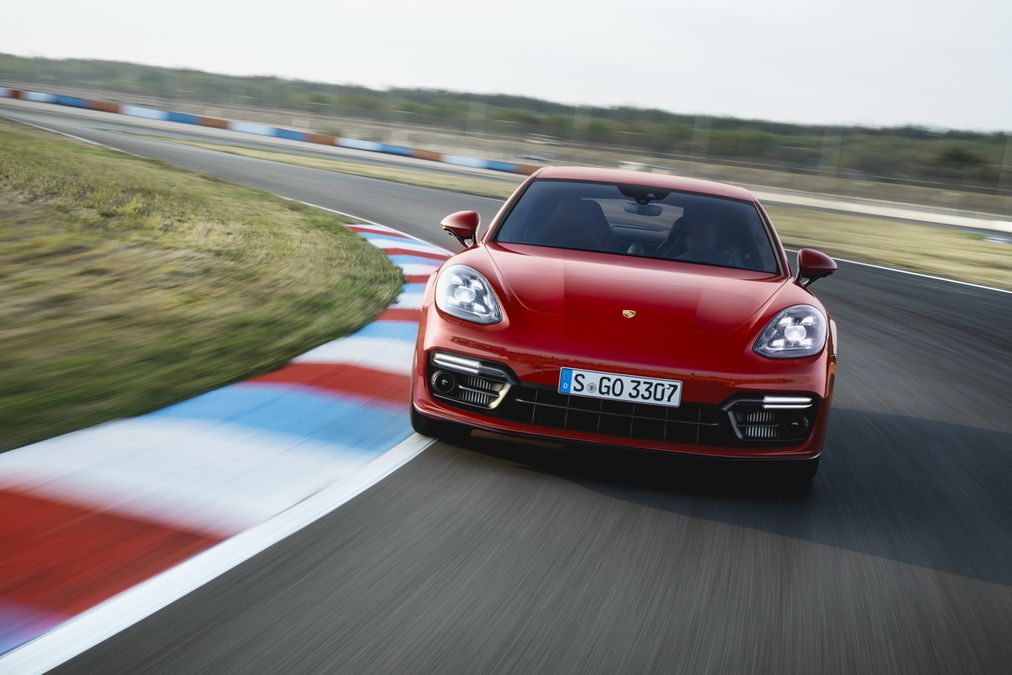Porsche's Panamera GTS is the practical sports car
Reloaded in second-generation guise, the Porsche Panamera GTS feels like a more mature and refined four-door version of the 911.

Think Porsche, think 911, right? Not any more. Yes, the iconic rear-engine sports car still rightly sits at the epicentre of Porsche’s universe. Yet the Stuttgart sports car maker has methodically and dramatically broadened its remit over the past couple of decades.
The talismanic 911 still underpins rowing global sales footprint, but it’s the launch of the Boxster convertible in ’96, the Cayenne SUV in 2003, the Cayman (a Boxster with a fixed roof) in 2005, and the Macan compact SUV in 2014 that has really turbocharged sales.
Also within that timeline came another important development in 2009 – the launch of the brand’s first four-door full-sized luxury sedan, the Panamera.
Eye-opening choice, eye-watering price
The second-generation Panamera range extends to 13 variants today, with prices spread from $214,800 to an eye-watering $466,400. Sandwiched somewhere between is the Panamera GTS, costing $364,100 plus on-road costs.
Depending on whether your tastes skew Brit, Italian or German, its rivals include Aston Martin’s Rapide S ($382,110), Maserati’s GranTurismo MC Stradale ($345,000), and Mercedes-AMG’s four-door GT63 S ($349,900).
Our test car, priced at $395,220, also sported a Mazda MX-5 worth of options including a special leather and Alcantara interior ($5980), night vision assist ($5890), Jet Black metallic 21-inch alloys ($5220), Tinted LED headlights with matric beam ($3490), power sunblinds for rear screen and side windows ($2940), lane change assist ($1890), traffic jam assist ($990), and power steering plus ($650).
The look and the feel
The Panamera GTS looks like a lot of money, being similar in length and wheelbase to other European F-segment players, such as the BMW 7 Series and Mercedes-Benz S-Class. It also tips the scales at a stout 1995kg, meaning you can at least feel where some of that hard-earned has gone.
Despite its imposing dimensions, the Panamera somehow manages to look sporty. There’s no mistaking it for anything other than a Porsche, with its soft-form curves, wide and powerful rear haunches, teardrop-shaped glasshouse, and 911-esque raised front fenders.
Beneath its long bonnet lurks a potent 4.0 litre twin-turbo V8, fed by two twin-scroll turbines. Mustering 338kW at 6000rpm and a continent-shifting 620Nm between 1900rpm and 4500rpm, the V8 is shaded for performance in the Panamera line-up only by the even higher-output Turbo and Turbo E-Hybrid models.
Adaptive air suspension sits the GTS a purposeful 10mm lower than other models, the body slammed over staggered-width tyres that fill the guards to bursting. In the high-performance Sport Plus it drops a further 10mm, while steep driveways can be negotiated via a selectable 30mm suspension lift.
Selling the drama
Drop into the low-slung driving position, get settled in the firmly sculpted leather and Alcantara-clad seat, twist the permanently-fixed faux key protruding from the dash, and brace as the engine fires with a violent, throat-clearing bark.
Snick the stubby shift lever back and listen as the eight-speed twin-clutch auto shuffles almost imperceptibly into first. Grasp the sensuous Alcantara-clad steering wheel and feel the immediate sense of connection between car and driver as you get rolling. The Panamera launches with visceral velocity, leaping off the line like a scalded cat, its electronically-regulated multi-plate clutch shuffling drive like a conductor to the axle that can best use it.
The twin-clutch gearbox, or ‘Doppelkupplung’, as the Germans so eloquently put it, fires in shifts at a furious pace, each at such lighting speed as to barely interrupt the furious mechanical onslaught.
The 100km/h mark is eclipsed in a blink-and-you’ll-miss-it 4.1secs, the unrelenting tidal wave of torque keeping you pinned to the seat as 200km/h evaporates in a barely credible 15.4 secs, the horizon reeling in at furious velocity until the GTS effortlessly settles at its mandated 292km/h top speed. Or so we’re told.
Relax and enjoy the ride
Having scared yourself silly in the interests of science, you can relax a little and enjoy the well thought-out ergonomics, the fundamental rightness of the driving position and the impressive tactility and responsiveness of the steering and brakes.
Inside, the luxuriously appointed cabin is dominated by those thin but beautifully sculpted sports seats, their integrated headrests embossed with the GTS logo; while in the second row, the wide transmission tunnel divides individual bucket seats, making this strictly a four-seater.
The unsightly cluster of buttons and switches that characterised early models has been replaced by slicker and more sophisticated capacitive-touch switches. Rear seat passengers get a similar treatment, with their own touch screen and controls for climate, audio and privacy screens.
A cracking drive
The V8 can be swiftly tamed via the steering wheel-mounted mode switch, which in Normal mode mimics a refined and relaxed urban cruiser. The suspension likewise shifts to its softest setting, but the sporting nature of the GTS means it can never ride as softly or comfortably as its luxury sedan rivals. Nor are the scalloped rear buckets ultimately as comfortable as you’ll find in these big sedans, though they’re far roomer than anything you’ll find in a 2+2 body style.
In some regards the Panamera feels like a more mature and refined four-door 911. It’s a cracking drive with a veneer of luxury and is, in every respect, a pukka Porsche; albeit one that you can comfortably ferry clients in, or maybe even take the family on a holiday road trip. Provided they pack light, and hold on tight.











Hi Guest, join in the discussion on Porsche's Panamera GTS is the practical sports car